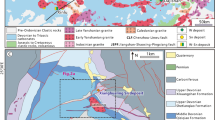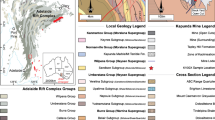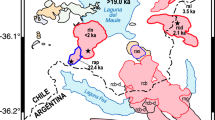Abstract
The microstructural development during the transformation of omphacite into pyroxene-plagioclase symplectites has been studied in some eclogites from the Seve nappe, Central Scandinavian Caledonides. The omphacite transformation can be described as a discontinuous precipitation reaction that occurred in two clearly defined stages to produce a coarser type A, followed by a finer, type B symplectite. Each type has its distinctive chemistry. The combination of microstructural and chemical characteristics of the transformation is used to reconstruct the early stages of the cooling history of the eclogites. In addition, based on a classification of phase transformations according to growth processes, the continuous exsolution reaction reported in high-temperature omphacites is combined with the discontinuous reaction in a time-temperature transformation (TTT) diagram to produce a more unified view of the exsolution in the omphacites.
Similar content being viewed by others
References
Anderson DL (1977) Composition of the mantle and core. Ann Rev Earth Planet Sci 5:179–202
Anderson DL (1979) Chemical stratification of the mantle. J Geophys Res 84:6297–6298
Boland JN (1980) Electron microscopy of mineral phase transformations in metamorphic reactions. In: Brederoo P, Boom G (eds) Electron microscopy, vol 1: Physics. North-Holland, Amsterdam, pp 444–451
Boland JN, McLaren AC, Hobbs BE (1971) Dislocations associated with optical features in naturally deformed olivine. Contrib Mineral Petrol 30:53–63
Carpenter MA (1978) Kinetic control of ordering and exsolution in omphacite. Contrib Mineral Petrol 67:17–24
Carpenter MA (1979a) Contrasting properties and behaviour of antiphase domains in pyroxene. Phys Chem Minerals 5:119–131
Carpenter MA (1979b) Experimental coarsening of antiphase domains in a silicate mineral. Science 206:681–683
Carpenter MA (1980) Mechanisms of exsolution in sodic pyroxenes. Contrib Mineral Petrol 71:289–300
Cawthorn RG, Collerson KD (1974) The recalculation of pyroxene endmember parameters and the estimation of ferrous and ferric iron content from electron microprobe analyses. Am Mineral 59:1203–1208
Champness PE (1973) Speculation on an order-disorder transformation in omphacite. Am Mineral 58:540–542
Champness PE, Lorimer GW (1976) Exsolution in silicates. In: Wenk H-R, Champness PE, Christie JM, Cowley JM, Heuer AH, Thomas G, Tighe NJ (eds) Electron microscopy in mineralogy. Springer, Berlin Heidelberg New York, pp 174–202
Champness PE, Cliff G, Lorimer GW (1981) Quantitative analytical electron microscopy. Bull Mineral 104:236–240
Cliff G, Lorimer GW (1975) The quantitative analysis of thin specimens. J Microsc 103:203–207
Deer WA, Howie RA, Zussman J (1978) Rock-forming minerals, vol 2A: Single chain silicates, 2nd edn. Wiley, New York
Ellis DJ, Green DH (1979) An experimental study of the effect of Ca upon garnet-clinopyroxene, Fe-Mg exchange equilibria. Contrib Mineral Petrol 71:13–22
Eskola P (1921) On the eclogites of Norway. Vidensk Selsk Skr K1 I, 8:1–118
Gasparik T, Lindsley DH (1980) Phase equilibria at high pressure of pyroxenes containing monovalent and trivalent ions. In: Prewitt CT (ed) Pyroxenes. Reviews in mineralogy vol 7. Mineralogical Society of America, Washington, pp 309–339
Geisler AH (1951) Precipitation from solid solutions of metals. In: Smulikowski R, Mayer JE, Weyl WA (eds) Phase transformations in solids. Wiley, New York, pp 387–544
Green DH, Ringwood AE (1967) An experimental investigation of the gabbro to eclogite transformation and its petrological applications. Geochim Cosmochim Acta 31:767–833
Griffin WL, Råheim A (1973) Convergent metamorphism of eclogites and dolerites, Kristiansund area, Norway. Lithos 6:21–40
Griffin WL, Austreheim A, Brastad K, Bryhni I, Kril A, Krogh E, Mørk MBE, Qvale H, Torndbakken B (1982) High pressure metamorphism in the Scandinavian Caledonides. In: Gee DG, Sturt BA (eds). The Caledonide Orogen — Scandinavia and related areas. Wiley, New York (in press)
Guy AG (1976) Essentials of materials science. McGraw-Hill, New York, Tokyo
Hernes I (1954) Eclogite-amphibolite on the Molde Peninsula, Southern Norway. Norsk Geol Tidsskr 33:163–183
Holland TJB (1980) The reaction albite-jadeite + quartz determined experimentally in the range 600–1,200° C. Am Mineral 65:129–134
Horiuchi S, Gokyu I (1969) Formation of recrystallized grains in heavily rolled sheet — influence of chemical driving force on the formation of recrystallized grains. In: Grewen J, Wasserman G (eds) Textures in research and practice. Springer, Berlin Heidelberg New York, pp 312–318
Ito K, Kennedy GC (1974) The composition of liquids formed by partial melting of eclogites at high temperatures and pressures. J Geol 82:383–392
Kushiro I (1965) Clinopyroxene solid solutions at high pressures. Ann Rep Dir Geophys Lab Washington Yearb 64:112–117
Martin JW, Doherty RD (1976) The stability of microstructures in metals. Cambridge University Press, Cambridge
McConnell JDC (1975) Microstructures of minerals as petrogenetic indicators. Ann Rev Earth Planet Sci 3:129–155
Mysen BO (1972) Five clinopyroxenes in the Hareidland eclogite Western Norway. Contrib Mineral Petrol 34:315–325
Mysen BO, Griffin WL (1973) Pyroxene stoichiometry and the breakdown of omphacite. Am Mineral 58:60–63
Nicholson RB, Davies GJ (1971) Development of microstructure. In: Finniston HM (ed) Structural characteristics of materials. Elsevier, Amsterdam, pp 199–289
Phakey PP, Ghose S (1973) Direct observation of anti-phase domain structure in omphacite. Contrib Mineral Petrol 39:239–245
Putnis A, McConnell JDC (1980) Principles of mineral behaviour. Blackwell, Oxford
Ringwood AE (1975) Composition and petrology of the earth's mantle. McGraw-Hill, New York
Ringwood AE (1979) Origin of the earth and moon. Springer, Berlin Heidelberg New York
Ringwood AE, Green DH (1966) An experimental investigation of the gabbro-eclogite transformation and some geophysical implications. Tectonophysics 3:283–427
Roermund HLM van (1982) Eclogites of the Seve Nappe, Jämtland, Central Scandinavian Caledonides. In: Gee DG, Sturt BA (eds) The Caledonide Orogen — Scandinavia and related areas. Wiley, New York (in press)
Roermund HLM van, Boland JN (1981) The dislocation substructures of naturally deformed omphacites. Tectonophysics 78:403–418
Shewmon PG (1969) Transformations in metals. McGraw-Hill, New York
Smyth JR (1980) Cation vacancies and the crystal chemistry of breakdown reactions in kimberlitic omphacites. Am Mineral 65:1185–1191
Spry A (1969) Metamorphic textures, Pergamon Press, Oxford
Stüwe HP (1978) Driving and dragging forces in recrystallization. In: Haessner F (ed) Recrystallization of metallic materials. Dr. Reidner Verlag. Stuttgart, pp 11–21
Vogel DE (1966) Nature and chemistry of the formation of clinopyroxene — plagioclase symplectite from omphacites. Neues Jahrb Mineral Monatsh 6:185–189
White S (1973) Dislocation structures responsible for the optical effects in some naturally deformed quartzites. J Mater Sci 8:490–499
Wikström A (1970) Electron-microprobe studies of the alteration of omphacite in eclogites from the Nordfjord area, Norway. Norsk Geol Tidssk 50:137–155
Williams PF, Zwart HJ (1977) A model for the development of the Seve-Köli Caledonian Nappe Complex. In: Saxena SK, Bhattacharji S (eds) Energetics of geological processes. Springer, New York, pp 169–187
Yund RA, McCallister RH (1970) Kinetics and mechanisms of exsolution. Chem Geol 6:5–30
Author information
Authors and Affiliations
Rights and permissions
About this article
Cite this article
Boland, J.N., van Roermund, H.L.M. Mechanisms of exsolution in omphacites from high temperature, type B, eclogites. Phys Chem Minerals 9, 30–37 (1983). https://doi.org/10.1007/BF00309467
Received:
Issue Date:
DOI: https://doi.org/10.1007/BF00309467




